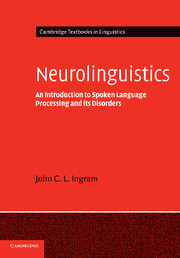Book contents
- Frontmatter
- Contents
- List of figures
- List of tables
- Preface and acknowledgements
- Note on the text
- Part I Foundational concepts and issues
- Part II Speech perception and auditory processing
- Part III Lexical semantics
- 9 Morphology and the mental lexicon
- 10 Lexical semantics
- 11 Lexical semantic disorders in aphasia
- Part IV Sentence comprehension
- Part V Discourse: language comprehension in context
- Glossary
- References
- Index
9 - Morphology and the mental lexicon
Published online by Cambridge University Press: 26 January 2010
- Frontmatter
- Contents
- List of figures
- List of tables
- Preface and acknowledgements
- Note on the text
- Part I Foundational concepts and issues
- Part II Speech perception and auditory processing
- Part III Lexical semantics
- 9 Morphology and the mental lexicon
- 10 Lexical semantics
- 11 Lexical semantic disorders in aphasia
- Part IV Sentence comprehension
- Part V Discourse: language comprehension in context
- Glossary
- References
- Index
Summary
Introduction
Our discussion thus far has been confined to problems of word recognition and the retrieval of phonological forms from the speech signal. But we have yet to address three core issues of language processing at the lexical level: (1) how word meanings are represented in the mental lexicon; (2) how lexical meanings are assigned to words in the context of sentence processing; and (3) the precise nature of the items which make up the mental lexicon, which we have thus far identified as ‘words’, but have not attempted to define with any precision.
We shall tackle the third of these questions first, the nature of items in the mental lexicon. Perhaps the fundamental issue here is: to what extent do language users decompose words into their constituent morphemes, or minimal units of meaning, as discussed in chapter 2? It is almost universally acknowledged, by linguists and psycholinguists alike, that the units of lexical representation are smaller than words, the units conventionally separated by white space in printed text. Few would argue, for example, that cat and cats, although they are clearly different words, constitute separate entries in the mental lexicon. Rather, cats is a morphological construction, made up of the lexemecat plus the plural inflectional suffix: i.e. cat + s. The assumption here is that in the course of processing words for meaning, listeners ‘strip’ inflectional affixes off word forms to access lexical meanings (Taft and Forster, 1976). But how far does this affix stripping extend?
- Type
- Chapter
- Information
- NeurolinguisticsAn Introduction to Spoken Language Processing and its Disorders, pp. 179 - 198Publisher: Cambridge University PressPrint publication year: 2007



